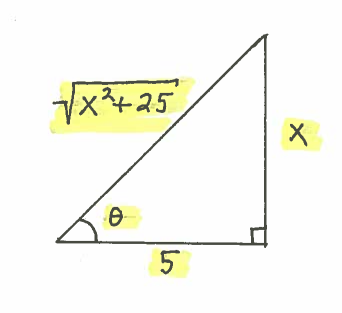SOLUTION 9: $ \ \ $ To integrate $ \displaystyle{ \int {
\sqrt{x^2+25} } \ dx } $ use the trig substitution
$$ x = 5 \tan \theta $$
so that
$$ dx = 5 \sec^{2} \theta \ d \theta $$
Substitute into the original problem, replacing all
forms of $ x $, getting
$$ \displaystyle {\int \sqrt{25 \tan^{2} \theta + 25} \cdot 5
\sec^{2} \theta \ d \theta } $$
$$ = \displaystyle { \int \sqrt{25 (\tan^{2} \theta + 1)} \ 5 \sec^{2}
\theta \ d \theta } $$
$$ = \displaystyle { 25 \int \sqrt{\tan^{2} \theta + 1} \ \sec^{2}
\theta \ d \theta } $$
$$ = \displaystyle { 25 \int \sqrt{\sec^{2} \theta} \ \sec^{2}
\theta \ d \theta } $$
$$ = \displaystyle { 25 \int \sec \theta \ \sec^{2} \theta \ d
\theta } $$
Now let's use integration by parts to integrate $ \ \displaystyle { \int \sec \theta \sec^{2} \theta \ d
\theta } = A $
. Let $ u = \sec \theta $ and $ dv = \sec^2 \theta \ d \theta $ , so that $ du = \sec \theta \tan \theta \ d \theta $ and $ v = \tan \theta $. Then
$$ A = \displaystyle { \int \sec \theta \sec^{2} \theta \ d \theta } $$
$$ = \sec \theta \tan \theta - \displaystyle { \int \sec \theta \tan^{2} \theta \ d \theta } $$
(Recall that $ \tan^2 \theta = \sec^2 \theta - 1$.)
$$ = \sec \theta \tan \theta - \displaystyle { \int \sec \theta \ ( \sec^{2} \theta - 1) \ d \theta } $$
$$ = \sec \theta \tan \theta - \displaystyle { \int ( \sec \theta \ \sec^{2} \theta - \sec \theta ) \ d \theta } $$
$$ = \sec \theta \tan \theta - \displaystyle { \int \sec \theta \ \sec^{2} \theta \ d \theta }
+ \displaystyle { \int \sec \theta \ d \theta } $$
(Recall that $ \displaystyle { \int \sec \theta \ d \theta } = \ln\Big| \sec \theta + \tan \theta \Big| + C $.)
$$ = \sec \theta \tan \theta - \displaystyle { \int \sec \theta \ \sec^{2} \theta \ d \theta }
+ \ln\Big| \sec \theta + \tan \theta \Big| + C $$
$$ = \sec \theta \tan \theta - A + \ln\Big| \sec \theta + \tan \theta \Big| + C $$
so that
$$ A = \sec \theta \tan \theta - A + \ln\Big| \sec \theta + \tan \theta \Big| + C \ \ \ \ \longrightarrow $$
$$ 2A = \sec \theta \tan \theta + \ln\Big| \sec \theta + \tan \theta \Big| + C \ \ \ \ \longrightarrow $$
$$ A = \frac{1}{2} \sec \theta \tan \theta + \frac{1}{2} \ln\Big| \sec \theta + \tan \theta \Big| + C $$
i.e.,
$$ \displaystyle { \int \sec \theta \sec^{2} \theta \ d
\theta } = \frac{1}{2} \sec \theta \tan \theta + \frac{1}{2} \ln\Big| \sec \theta + \tan \theta \Big| + C $$
Returning to our original problem we have that
$$ \displaystyle{ \int {\sqrt{x^2+25} } \ dx } = 25 \displaystyle { \int \sec \theta \ \sec^{2} \theta \ d
\theta } $$
$$ = 25 \Big( \frac{1}{2} \sec \theta \tan \theta + \frac{1}{2} \ln\Big| \sec \theta + \tan \theta \Big| + C \Big) $$
$$ = \frac{25}{2} \sec \theta \tan \theta + \frac{25}{2} \ln\Big| \sec \theta + \tan \theta \Big| + C $$
$ \Big($ Note that $ \ C = 25C \ $ in this context. Now we need to write our final answer in terms of $x$.

Since $ x = 5 \tan \theta $ it follows that
$$ \tan \theta = \displaystyle{ x \over 5 } = \displaystyle{ opposite \over adjacent } $$
and from the Pythagorean Theorem that
$$ \displaystyle (adjacent)^2 + (opposite)^2 = (hypotenuse)^2
\ \ \longrightarrow $$
$$ (5)^2 + (x)^2 = (hypotenuse)^2
\ \ \longrightarrow \ \ \ hypotenuse = \sqrt{25+x^2} \ \ \longrightarrow $$
$$ \sec \theta = \displaystyle{ hypotenuse \over adjacent }= \displaystyle{ \sqrt{25+x^2} \over 5 } . \Big) $$
$$ = \frac{25}{2} \displaystyle{ \sqrt{25+x^2} \over 5 } \displaystyle{ x \over 5 } + \frac{25}{2} \ln\Big| \displaystyle{ \sqrt{25+x^2} \over 5 } + \displaystyle{ x \over 5 } \Big| + C $$
$$ = \frac{1}{2} \displaystyle{ x \sqrt{25+x^2}} + \frac{25}{2} \ln\Big| \displaystyle{ \sqrt{25+x^2} \over 5 } + \displaystyle{ x \over 5 } \Big| + C $$
Click HERE to return to the list of problems.

